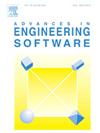An application of machine learning for geometric optimization of a dual-throat bent nozzle
IF 5.7
2区 工程技术
Q2 COMPUTER SCIENCE, INTERDISCIPLINARY APPLICATIONS
引用次数: 0
Abstract
The optimal thrust shape for a dual-throat bent nozzle (DTBN), designed as a hybrid thrust vectoring nozzle, is derived through machine learning. A compressible, steady-state numerical analysis using the SST model is employed for model construction. The main geometric parameters that determine the shape of the DTBN are selected as the convergence angle , divergence angle , and cavity length . By varying these parameters, DTBN models with a total of 600 different geometries are generated, and the axial and normal forces at the nozzle exit are observed to derive the thrust magnitude and thrust vectoring angle. A model that can accurately predict the correlation between input and output parameters is built by comparing various machine learning algorithms. The model using the random forest regression algorithm shows the best performance. Based on this developed machine learning model, optimized shapes of the DTBN are presented. The optimally designed DTBNs are expected to contribute to the development of a new system with more convenient thrust control.
机器学习在双喉弯喷嘴几何优化中的应用
采用机器学习的方法,推导出混合推力矢量喷管的最佳推力形状。使用k−ω海表温度模型的可压缩稳态数值分析用于模型构建。选择决定DTBN形状的主要几何参数为会聚角θc、发散角θd和腔长lc。通过改变这些参数,生成了总共600种不同几何形状的DTBN模型,并观察了喷管出口的轴向力和法向力,得出了推力大小和推力矢量角。通过比较各种机器学习算法,建立了一个能够准确预测输入和输出参数之间相关性的模型。采用随机森林回归算法的模型表现出最好的性能。基于该机器学习模型,给出了优化后的DTBN形状。优化设计的dtbn有望为开发一种更方便的推力控制的新系统做出贡献。
本文章由计算机程序翻译,如有差异,请以英文原文为准。
求助全文
约1分钟内获得全文
求助全文
来源期刊

Advances in Engineering Software
工程技术-计算机:跨学科应用
CiteScore
7.70
自引率
4.20%
发文量
169
审稿时长
37 days
期刊介绍:
The objective of this journal is to communicate recent and projected advances in computer-based engineering techniques. The fields covered include mechanical, aerospace, civil and environmental engineering, with an emphasis on research and development leading to practical problem-solving.
The scope of the journal includes:
• Innovative computational strategies and numerical algorithms for large-scale engineering problems
• Analysis and simulation techniques and systems
• Model and mesh generation
• Control of the accuracy, stability and efficiency of computational process
• Exploitation of new computing environments (eg distributed hetergeneous and collaborative computing)
• Advanced visualization techniques, virtual environments and prototyping
• Applications of AI, knowledge-based systems, computational intelligence, including fuzzy logic, neural networks and evolutionary computations
• Application of object-oriented technology to engineering problems
• Intelligent human computer interfaces
• Design automation, multidisciplinary design and optimization
• CAD, CAE and integrated process and product development systems
• Quality and reliability.
 求助内容:
求助内容: 应助结果提醒方式:
应助结果提醒方式:


